+ Open data
Open data
- Basic information
Basic information
| Entry | Database: EMDB / ID: EMD-21843 | |||||||||
|---|---|---|---|---|---|---|---|---|---|---|
| Title | TASK2 in MSP1D1 lipid nanodisc at pH 6.5 | |||||||||
 Map data Map data | pH 6.5 | |||||||||
 Sample Sample |
| |||||||||
 Keywords Keywords | Potassium ion channel / K2P channel / TRANSPORT PROTEIN | |||||||||
| Function / homology |  Function and homology information Function and homology informationPhase 4 - resting membrane potential / potassium ion export across plasma membrane / potassium ion leak channel activity / regulation of resting membrane potential / outward rectifier potassium channel activity / potassium ion import across plasma membrane / voltage-gated potassium channel activity / potassium channel activity / potassium ion transmembrane transport / protein heterodimerization activity / plasma membrane Similarity search - Function | |||||||||
| Biological species |  | |||||||||
| Method | single particle reconstruction / cryo EM / Resolution: 3.45 Å | |||||||||
 Authors Authors | Li B / Brohawn SG | |||||||||
| Funding support |  United States, 1 items United States, 1 items
| |||||||||
 Citation Citation |  Journal: Nature / Year: 2020 Journal: Nature / Year: 2020Title: Structural basis for pH gating of the two-pore domain K channel TASK2. Authors: Baobin Li / Robert A Rietmeijer / Stephen G Brohawn /  Abstract: TASK2 (also known as KCNK5) channels generate pH-gated leak-type K currents to control cellular electrical excitability. TASK2 is involved in the regulation of breathing by chemosensory neurons of ...TASK2 (also known as KCNK5) channels generate pH-gated leak-type K currents to control cellular electrical excitability. TASK2 is involved in the regulation of breathing by chemosensory neurons of the retrotrapezoid nucleus in the brainstem and pH homeostasis by kidney proximal tubule cells. These roles depend on channel activation by intracellular and extracellular alkalization, but the mechanistic basis for TASK2 gating by pH is unknown. Here we present cryo-electron microscopy structures of Mus musculus TASK2 in lipid nanodiscs in open and closed conformations. We identify two gates, distinct from previously observed K channel gates, controlled by stimuli on either side of the membrane. Intracellular gating involves lysine protonation on inner helices and the formation of a protein seal between the cytoplasm and the channel. Extracellular gating involves arginine protonation on the channel surface and correlated conformational changes that displace the K-selectivity filter to render it nonconductive. These results explain how internal and external protons control intracellular and selectivity filter gates to modulate TASK2 activity. | |||||||||
| History |
|
- Structure visualization
Structure visualization
| Movie |
 Movie viewer Movie viewer |
|---|---|
| Structure viewer | EM map:  SurfView SurfView Molmil Molmil Jmol/JSmol Jmol/JSmol |
| Supplemental images |
- Downloads & links
Downloads & links
-EMDB archive
| Map data |  emd_21843.map.gz emd_21843.map.gz | 14.4 MB |  EMDB map data format EMDB map data format | |
|---|---|---|---|---|
| Header (meta data) |  emd-21843-v30.xml emd-21843-v30.xml emd-21843.xml emd-21843.xml | 14.1 KB 14.1 KB | Display Display |  EMDB header EMDB header |
| Images |  emd_21843.png emd_21843.png | 70 KB | ||
| Filedesc metadata |  emd-21843.cif.gz emd-21843.cif.gz | 5.7 KB | ||
| Archive directory |  http://ftp.pdbj.org/pub/emdb/structures/EMD-21843 http://ftp.pdbj.org/pub/emdb/structures/EMD-21843 ftp://ftp.pdbj.org/pub/emdb/structures/EMD-21843 ftp://ftp.pdbj.org/pub/emdb/structures/EMD-21843 | HTTPS FTP |
-Validation report
| Summary document |  emd_21843_validation.pdf.gz emd_21843_validation.pdf.gz | 474.7 KB | Display |  EMDB validaton report EMDB validaton report |
|---|---|---|---|---|
| Full document |  emd_21843_full_validation.pdf.gz emd_21843_full_validation.pdf.gz | 474.3 KB | Display | |
| Data in XML |  emd_21843_validation.xml.gz emd_21843_validation.xml.gz | 5.7 KB | Display | |
| Data in CIF |  emd_21843_validation.cif.gz emd_21843_validation.cif.gz | 6.5 KB | Display | |
| Arichive directory |  https://ftp.pdbj.org/pub/emdb/validation_reports/EMD-21843 https://ftp.pdbj.org/pub/emdb/validation_reports/EMD-21843 ftp://ftp.pdbj.org/pub/emdb/validation_reports/EMD-21843 ftp://ftp.pdbj.org/pub/emdb/validation_reports/EMD-21843 | HTTPS FTP |
-Related structure data
| Related structure data |  6wlvMC  6wm0C M: atomic model generated by this map C: citing same article ( |
|---|---|
| Similar structure data | |
| EM raw data |  EMPIAR-10423 (Title: TASK2 in MSP1D1 lipid nanodisc at pH6.5 / Data size: 2.0 TB EMPIAR-10423 (Title: TASK2 in MSP1D1 lipid nanodisc at pH6.5 / Data size: 2.0 TBData #1: multi-frame micrographs for ion channel TASK2 in closed state [micrographs - multiframe]) |
- Links
Links
| EMDB pages |  EMDB (EBI/PDBe) / EMDB (EBI/PDBe) /  EMDataResource EMDataResource |
|---|---|
| Related items in Molecule of the Month |
- Map
Map
| File |  Download / File: emd_21843.map.gz / Format: CCP4 / Size: 15.6 MB / Type: IMAGE STORED AS FLOATING POINT NUMBER (4 BYTES) Download / File: emd_21843.map.gz / Format: CCP4 / Size: 15.6 MB / Type: IMAGE STORED AS FLOATING POINT NUMBER (4 BYTES) | ||||||||||||||||||||||||||||||||||||||||||||||||||||||||||||||||||||
|---|---|---|---|---|---|---|---|---|---|---|---|---|---|---|---|---|---|---|---|---|---|---|---|---|---|---|---|---|---|---|---|---|---|---|---|---|---|---|---|---|---|---|---|---|---|---|---|---|---|---|---|---|---|---|---|---|---|---|---|---|---|---|---|---|---|---|---|---|---|
| Annotation | pH 6.5 | ||||||||||||||||||||||||||||||||||||||||||||||||||||||||||||||||||||
| Projections & slices | Image control
Images are generated by Spider. | ||||||||||||||||||||||||||||||||||||||||||||||||||||||||||||||||||||
| Voxel size | X=Y=Z: 1.137 Å | ||||||||||||||||||||||||||||||||||||||||||||||||||||||||||||||||||||
| Density |
| ||||||||||||||||||||||||||||||||||||||||||||||||||||||||||||||||||||
| Symmetry | Space group: 1 | ||||||||||||||||||||||||||||||||||||||||||||||||||||||||||||||||||||
| Details | EMDB XML:
CCP4 map header:
| ||||||||||||||||||||||||||||||||||||||||||||||||||||||||||||||||||||
-Supplemental data
- Sample components
Sample components
-Entire : TASK2 in MSP1D1 lipid nanodisc at pH 6.5
| Entire | Name: TASK2 in MSP1D1 lipid nanodisc at pH 6.5 |
|---|---|
| Components |
|
-Supramolecule #1: TASK2 in MSP1D1 lipid nanodisc at pH 6.5
| Supramolecule | Name: TASK2 in MSP1D1 lipid nanodisc at pH 6.5 / type: complex / ID: 1 / Parent: 0 / Macromolecule list: #1 |
|---|---|
| Source (natural) | Organism:  |
| Molecular weight | Theoretical: 77 KDa |
-Macromolecule #1: Potassium channel TASK2
| Macromolecule | Name: Potassium channel TASK2 / type: protein_or_peptide / ID: 1 / Number of copies: 2 / Enantiomer: LEVO |
|---|---|
| Source (natural) | Organism:  |
| Molecular weight | Theoretical: 38.533703 KDa |
| Recombinant expression | Organism:  Komagataella pastoris (fungus) Komagataella pastoris (fungus) |
| Sequence | String: MVDRGPLLTS AIIFYLAIGA AIFEVLEEPH WKEAKKNYYT QKLHLLKEFP CLSQEGLDKI LQVVSDAADQ GVAITGNQTF NNWNWPNAM IFAATVITTI GYGNVAPKTP AGRLFCVFYG LFGVPLCLTW ISALGKFFGG RAKRLGQFLT RRGVSLRKAQ I TCTAIFIV ...String: MVDRGPLLTS AIIFYLAIGA AIFEVLEEPH WKEAKKNYYT QKLHLLKEFP CLSQEGLDKI LQVVSDAADQ GVAITGNQTF NNWNWPNAM IFAATVITTI GYGNVAPKTP AGRLFCVFYG LFGVPLCLTW ISALGKFFGG RAKRLGQFLT RRGVSLRKAQ I TCTAIFIV WGVLVHLVIP PFVFMVTEEW NYIEGLYYSF ITISTIGFGD FVAGVNPSAN YHALYRYFVE LWIYLGLAWL SL FVNWKVS MFVEVHKAIK KRRRRRKESF ESSPHSRKAL QMAGSTASKD VNIFSFLSKK EETYNDLIKQ IGKKAMKTSG GGE RVPGPG HGLGPQGDRS NSLEVLF UniProtKB: Potassium channel TASK2 |
-Macromolecule #2: POTASSIUM ION
| Macromolecule | Name: POTASSIUM ION / type: ligand / ID: 2 / Number of copies: 3 / Formula: K |
|---|---|
| Molecular weight | Theoretical: 39.098 Da |
-Experimental details
-Structure determination
| Method | cryo EM |
|---|---|
 Processing Processing | single particle reconstruction |
| Aggregation state | particle |
- Sample preparation
Sample preparation
| Concentration | 1.2 mg/mL | ||||||||||||
|---|---|---|---|---|---|---|---|---|---|---|---|---|---|
| Buffer | pH: 6.5 Component:
| ||||||||||||
| Grid | Model: Quantifoil R1.2/1.3 / Material: GOLD / Mesh: 300 / Support film - Material: CARBON / Support film - topology: HOLEY / Support film - Film thickness: 12 / Pretreatment - Type: GLOW DISCHARGE / Pretreatment - Time: 30 sec. / Pretreatment - Atmosphere: AIR | ||||||||||||
| Vitrification | Cryogen name: ETHANE / Chamber humidity: 100 % / Chamber temperature: 277 K / Instrument: FEI VITROBOT MARK IV Details: Incubate 5 seconds, blot 3s seconds, blot force 1. |
- Electron microscopy
Electron microscopy
| Microscope | FEI TALOS ARCTICA |
|---|---|
| Image recording | Film or detector model: GATAN K3 (6k x 4k) / Digitization - Dimensions - Width: 11520 pixel / Digitization - Dimensions - Height: 8184 pixel / Number grids imaged: 1 / Number real images: 2683 / Average exposure time: 0.11 sec. / Average electron dose: 0.98714 e/Å2 |
| Electron beam | Acceleration voltage: 200 kV / Electron source:  FIELD EMISSION GUN FIELD EMISSION GUN |
| Electron optics | C2 aperture diameter: 100.0 µm / Illumination mode: FLOOD BEAM / Imaging mode: BRIGHT FIELD / Cs: 2.7 mm / Nominal defocus max: 2.0 µm / Nominal defocus min: 0.8 µm |
| Sample stage | Cooling holder cryogen: NITROGEN |
| Experimental equipment |  Model: Talos Arctica / Image courtesy: FEI Company |
+ Image processing
Image processing
-Atomic model buiding 1
| Refinement | Space: REAL / Protocol: OTHER / Overall B value: 151.61 |
|---|---|
| Output model |  PDB-6wlv: |
 Movie
Movie Controller
Controller



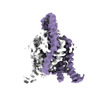

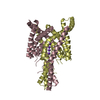
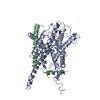

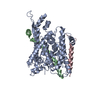
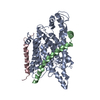
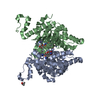
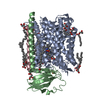
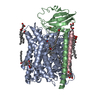


 X (Sec.)
X (Sec.) Y (Row.)
Y (Row.) Z (Col.)
Z (Col.)





















